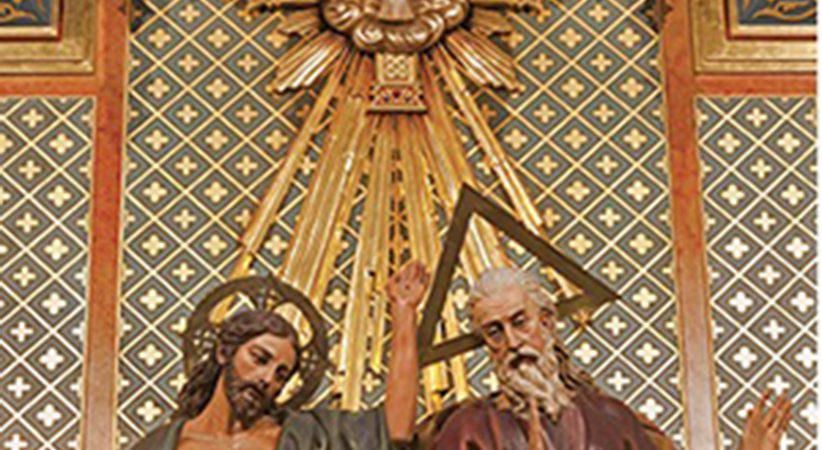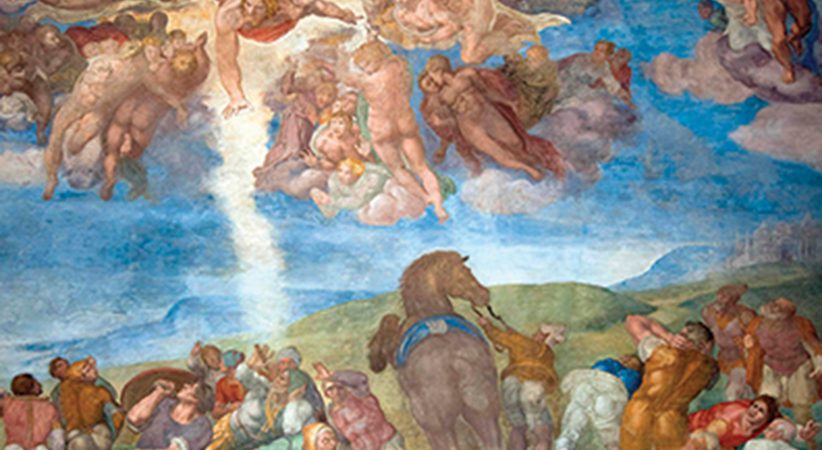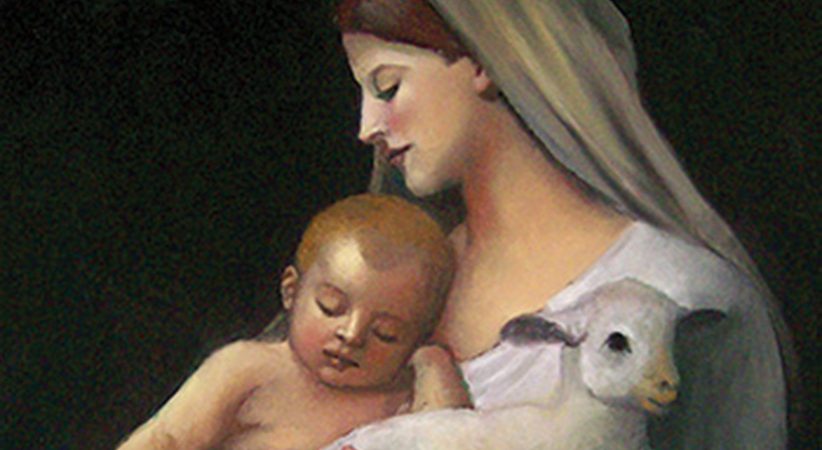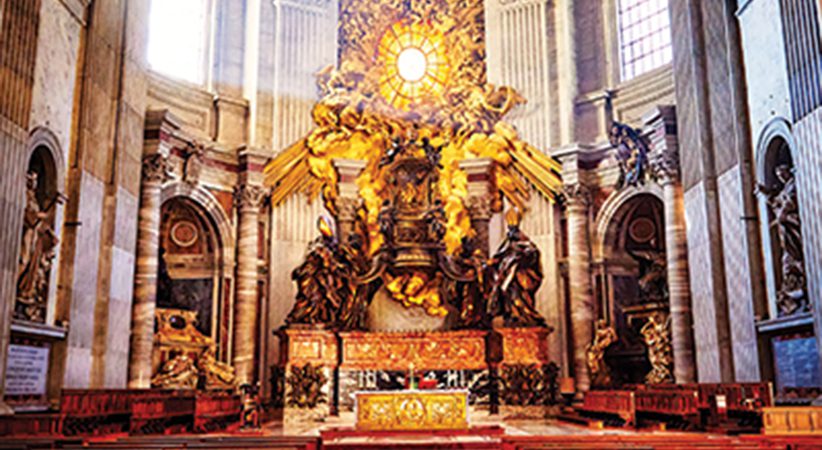Trinity Sunday and the Fathers
Trinitarian relationships reflect aspects of Christian life
Father Douglas J. Milewski Comments Off on Trinity Sunday and the Fathers
To celebrate Mass is to enter into the theological and spiritual world of the ancient Church, because the Church’s Eucharistic liturgies — Eastern and Western — are fundamentally patristic “texts” shaped by the Fathers as much as they were shaped by worship. The solemnity of the Most Holy Trinity offers for contemplation within the context of the liturgy the Fathers’ most vital achievement — the Church’s normative answer to her two most urgent questions: Who is Jesus Christ? What is the Christian understanding of God?
Answering these questions was no rarified debate among academics, but something relevant to every layman and pastor of the Church because the Mass is the common “property” and concern of all the faithful. It seems only fitting, then, to propose a few observations on the Fathers’ Trinitarianism with an eye to the liturgy and the people who offer it as individuals and as a community.
Symbol of the Faith
The Creed is called the symbolum fidei because it teaches the unique summary of Christian belief. Yet one may consider, too, how the process by which the Creed was finalized provides lasting lessons to the Church on how she struggles to arrive at definitive doctrinal articulations. The 126 years between the First Council of Nicaea in 325 and Chalcedon in 451 are unequalled for the intense maturation in Trinitarian and Christological theology. It was also a period during which disputes of the day make modern post-conciliar squabbles seem tame by comparison. Given the tectonic nature of the issues involved the situation could hardly be otherwise. However, the conditions under which this development proceeded only exacerbated things.
| Love of the Trinity |
|---|
 “Love, therefore, which is of God
and is God, is specially the Holy
Spirit, by whom the love of God
is shed abroad in our hearts, by
which love the whole Trinity
dwells in us.”
— St. Augustine, De Trinitate 15.32
|
First, there were external pressures brought about by the intrusions of Constantine and his heirs based on their unshaken confidence in a supposed right to facilitate the Church’s doctrinal decision-making. These actions reflected those emperors’ concept of political order, but also a sincere, albeit mistaken, conviction about their role in the Church.
The complexity of the questions and the uncertainty of the terminology to be embraced required time for reflection and dialogue, not the “help” of iron-fisted imperial interventions. Nicaea’s homoousios (“same substance”) had originally been understood in a certain way in the previous century to render it suspect. The term had to be reunderstood. Yet, the knottier the question, the greater the appeal of a compromise formula — of “something everyone can agree on” — grew. This gave rise to the expression homoiousios (“similar substance”). The imposition of that vague formula by the pro-Arian emperor Constantius II in 359 served only to deepen the confusion. As St. Jerome famously described the situation, “The world groaned and marveled to discover it had become Arian” (Dialogue with a Luciferian, No. 19).
The squishiness of deliberate obfuscation offered no foundation to build upon. However, resourceful thinkers realized that if homoousios had to be reunderstood in the fourth century apart from its earlier third-century sense, so, too, could homoiousios be utilized to begin differentiating stark Arians from those who were simply unsure yet about what Nicaea intended. This required nimbleness of mind, not trenchancy. Men revered today for their bold devotion to the Faith, such as St. Athanasius and St. Hilary of Poitiers, well understood this dynamic. Riskier was taking a position overly devoted to defending one doctrinal development compared to the exclusion of grasping broader understandings. Witness the unfortunate Apollinaris of Laodicea who so zealously sought to defend the Nicene doctrine that he argued himself into a Christology condemned at Constantinople in 381. It could be tricky to tell the wheat from the chaff. Nestorius, condemned in 431 at Ephesus, lived to concur with the core teachings of Chalcedon, while the devotees of his then-deceased nemesis, St. Cyril of Alexandria, headed off into schism.
One may justifiably ask if these debates were handled with the charity, patience and fraternity the Gospel enjoins. Yet it is the Gospel itself that explains the intensity. The Fathers understood that questions of the Trinity and Christ are inseparable, and, likewise, they could only be answered if placed before the full sources of revelation, beginning with Scripture and extending to liturgy and Christian praxis. They realized that when Thomas touched a human body and exclaimed, “My Lord and my God!” (Jn 20:28), traditional monotheism needed rethinking. So, too, when someone who seemed only a human dared to forgive sins (see Mt 9:2), “correct” the Ten Commandments (Mt 5:21-22, 27-28) or establish a “covenant” (Mt 26:28). For each verse that spoke of Christ as less than the Father (Jn 14:28), one had to grapple with those times when he spoke of being one with the Father (Jn 10:30).
Further complicating the matter for traditional monotheism are those incidents when the gift of the Holy Spirit empowers the apostles to exercise the divine prerogative to forgive sins (see Jn 20:23) or when the new life of baptism is to be imparted in the name of the Father, the Son and the Holy Spirit (Mt 28:19). As St. Basil of Caesarea observed, the Church has never baptized in the name of “the first, the second and the third,” but rather in the names of three equals (see Basil’s The Holy Spirit 24-28, 43-45). Doctrinal conclusions regarding the Trinity and Christ could not be arrived at in isolation from the rest of the “rule of faith,” which encompassed for the Fathers the whole gambit of revelation entrusted to the Church. These essential elements of the Christian dispensation had to harmonize with and inform each other. We will now consider some of the ways the Fathers saw Trinitarian reflection deepening Christian life.
The Relationality of God
St. Hilary of Poitiers was struck by the fact that Scripture makes two seemingly irreconcilable assertions: On the one hand there is and can only be one Creator, and on the other hand Christ is referred to as the one through whom all things were made (see Jn 1:3; 1 Cor 8:6; Col 1:16-17). The Bible does not allow for any co-God or assistant Creator alongside the One God. In some way, these two actions of all things coming from God and into being through Christ have to be the work of a single Being. Hilary’s conclusion is that the One God, therefore, cannot be a Being in isolation. To affirm God as solitary is as dangerous as denying God (The Trinity 7.3). There must be something relational within the very life of God himself. The famous “dialogue” at the creation of man in Genesis 1:26 further illustrates this most basic point for him (4.18).
It is with this conviction in mind — that monotheism is not the same thing as a divine solitary Being — that Hilary considers the most salient feature of the New Testament’s language about God: the names Father and Son. The eternity of those names impress him profoundly, for any suggestion of a temporal quality to them would require change in God and thus not really be God (see The Trinity 12.32-34). What is more, those names are not simply relational in a vague sense but expressive of relations graspable to the human mind and experience. It is this Being, Hilary realizes, who freely called him into existence and fashioned him in his image. The marvel of human creation, already a revolutionary belief in the Old Testament, acquires unimagined new meaning through Trinitarian belief.
Image of God, Image of the Trinity
Hilary’s Trinitarian theology found a great admirer in St. Augustine. Indeed, in the bishop of Hippo’s De Trinitate, Hilary is the only theologian mentioned by name. Augustine was particularly captivated by his predecessor’s creative discoveries of “lesser trinities” to evoke the mystery of God, especially the Father as Eternity, the Son as Image and the Spirit as Gift (see De Trinitate 6.11). Augustine’s own masterpiece would become duly famous for its own “trinities” as further explorations of the implications raised by Hilary that humans, created in the image of God, must therefore be the image of the Trinity.
Of the triads considered by Augustine, perhaps the most significant is that of memory, thought and will (see De Trinitate 12.25), three distinct yet inseparable functions of the mind. Each of these has limitless capacities for what they can retain and consider. They are apt indicators of how humans are made for God. And yet, these would not correspond to the genuine “inner person” who is God’s true image unless these functions are stimulated and accompanied by love, which is the essential perfecting piece to the puzzle.
Love is also Augustine’s word for the Holy Spirit, the Third Person in the Holy Trinity uniting the One Loving/the Father with the One Loved/the Son (see De Trinitate 8.14; 9.2; 15.32). The introduction of Love/the Holy Spirit into his Trinitarian anthropology broadens the reflection to an ecclesial dimension. To receive the Holy Spirit is to receive the two outpourings on the disciples which Augustine enumerates. The first occurs on the night of the Resurrection (Jn 20:23) with the commission to forgive sins and corresponds to the Church’s earthly mission and the command to love neighbor. The second is at Pentecost (Acts 2:1-4) which is bestowed from heaven and corresponds to the command to love God (De Trinitate 15.46). To profess the Church as the Body of Christ is to proclaim that one meets Christ in the Church and, thus, the Triune God. To be part of the Body of Christ, therefore, is to become in oneself an encounter point with the Trinity and thereby find in the Church the completion of one’s humanity.
The Life of the Church and the Life of the Trinity
Augustine’s congregation was not the sort to lull any pastor into a romanticized notion of a Christian community. They were a tumultuous bunch, struggling with a wide array of sins and vulnerable to explosive outbursts. In one famous episode, the parishioners presented a man to Augustine for ordination in the same fashion by which he himself had been made a priest: dragged before the altar without having the chance to declare his consent. In this incident, both the would-be ordinand and the bishop were unwilling to grant the flock’s wish. A fight nearly broke out in the church. Writing to the mother of the poor man at the center of the controversy, Augustine reassured her that her son’s life never really was in danger, though it might have appeared that way once or twice (see Letter 126).
Apropos of his conviction that the “inner person” bears traces of the Trinity, Augustine remained firm that the transformation of baptism explicitly imparted Christ’s presence in the Christian, the “Christ within,” or Christus intus. Wherever Christ was to be found, according to Augustine, there, too, was the fullness of God, the Trinity (Tractates 104.1 and 110.3). Ever a realist when it came to acknowledging human foibles, Augustine was always a Christian realist, which meant he could not deny what God had created, especially the Trinitarian basis of anthropology and ecclesiology. Thus even seemingly ordinary liturgical actions must be Christocentric: “The lector gets up to read, and Christ is not silent. The preacher speaks; Christ speaks” (Sermon 17.1).
One sees this sensibility most clearly in his theology of preaching. Augustine’s understanding of preaching has more in common with basic sacramental concepts than even with principles of classical rhetoric. Preaching is a matter of teaching, and all teaching involves conveying realities through signs, in this case speech and language (see Christian Doctrine 1.2.2). Yet the preacher is not broadcasting his own brilliance or insights, first, because “we are called the teachers of the Scriptures, not the affirmers of our own opinions” (Sermon 270.3). Moreover, the congregation is not merely a collection of pupils, but a gathering of those who bear within themselves the same Christus intus who enables the preacher to speak. For this reason, Augustine could encourage his listeners to reflect on what was said and to offer to him any insights of their own. Of critical importance, then, was the preacher’s relationship to Christ within himself. Or, as Augustine put it more directly, “Let him be someone who prays before he is someone who speaks” (Christian Doctrine 4.87).
We Dare To Say
The priority Augustine gives to prayer in fulfilling one’s Christian duty leads to the personal prayer with priority over all others. The Fathers devote a number of marvelous reflections to the Our Father, but perhaps none is as sublime as St. Gregory of Nyssa’s Five Sermons on the Lord’s Prayer. In them he traces a thoroughly Trinitarian action that transforms the one praying into truly the imago Trinitatis.
But first he warns of the perils contained in such a prayer. It is no trifling thing to invoke God as “Father,” for it carries a judgment with it. The truth of such a relational claim must be supported by the goodness of one’s life. An evident “family resemblance” between one’s life and the heavenly Father is required, lest one find oneself invoking an infernal father to whom one might bear a stronger likeness (see Sermon 2 on the Lord’s Prayer). Thus an examination of conscience must preceed this prayer, which then advances either with appropriate confidence or with due contrition: “I think it is necessary to make this before all else the principal part of the prayer — that the Name of God might not be blasphemed but hallowed and glorified through my life” (Sermon 3).
|
Like what you’re reading? Subscribe now.
|
What follows next in Gregory’s exposition is the outpouring of the Holy Spirit upon the person praying. This is what it means to beg for the “Kingdom come.” The coming of the Kingdom is nothing short of the Spirit arriving in kingly power with his purifying gifts (see Sermon 3). The recipient of these gifts then becomes the “earth” upon which the Father’s will shall be accomplished (Sermon 4). The heavenly and earthly intertwine to where one would become even a partner with God in the forgiveness of sins (Sermon 5). Gregory’s Trinitarian construct of the prayer echoes sacramental and liturgical notes. It is a prayer for one’s own consecration by the Trinity to become a reflection of the Trinity.
These are but a few and brief glimpses into how the Fathers found Trinitarian resonances throughout all aspects of Christian life. Hopefully they stimulate further reflection on the implications of the central Christian mystery, not least in relation to the central act of Christian worship, to which connection Trinity Sunday draws our minds. It seems necessary, then, to conclude with sentiments similar to Augustine’s at the end of De Trinitate: For whatever here is true and beneficial may God be acknowledged, and for whatever is not may he and his people pardon!
FATHER DOUGLAS J. MILEWSKI is a priest of the Archdiocese of Newark, New Jersey, and holds a doctorate in patristic theology and sciences. He teaches theology at the archdiocese’s Seton Hall University.





